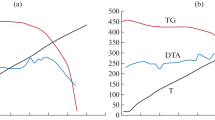Abstract
The effect of the combination of pressure annealing and subsequent hydrostatic extrusion on some mechanical properties of composites of hydroxyapatite in a polyethylene matrix is examined. Both linear and branched polyethylenes have been used as the matrix and it is found that composites with the former can be processed to give the higher modulus. An important practical finding is that products with a Young's modulus well into the range shown by cortical bone can be produced. The critical step in the enhancement of the modulus is pressure annealing which alters the morphology of the linear polyethylene, encouraging the development of both crystallinity and crystallite size. The presence of butyl branches along the molecular backbone limits the extent to which these can be developed by pressure annealing and accounts for the failure of the process to improve the modulus of composites using the branched material. Comparison with similarly prepared samples of the pure polyethylenes shows that the development of orientation in the polyethylene is considerably restricted by the presence of hydroxyapatite particles, irrespective of whether pressure annealing is performed prior to extrusion. Consequently, the properties of these composites are less than might be expected from studies on the isolated polyethylenes.
Similar content being viewed by others
References
W. Bonfield, J. Biomed. Eng. 10 (1988) 522.
Idem., Ann. New York Acad. Sci. 253 (1988) 173.
D. T. Reilly and A. H. Burstein, J. Bone Jnt. Surg. 56–A (1974) 4.
N. H. Ladizesky, I. M. Ward and W. Bonfield, J. Appl. Pol. Sci. 65 (1997) 1865.
M. Wang, N. H. Ladizesky, K. E. Tanner, I. M. Ward and W. Bonfield, J. Mater. Sci. 35 (2000) 1023.
M. M. Shahin, R. H. Olley, D. C. Bassett, A. S. Maxwell, A. P. Unwin and I. M. Ward, ibid. 31 (1996) 5541.
A. S. Maxwell, A. P. Unwin and I. M. Ward, Polymer 37 (1996) 3283.
H. H. Moroi, K. Okimoto, R. Moroi and Y. Terada, Int. J. Prosthodontics 6 (1993) 564.
M. J. Troughton, G. R. Davies and I. M. Ward, Polymer 30 (1989) 990.
J. Heijboer, P. Deking and A. J. Staverman, in Proc. Int. Cong. Rheol. (Butterworth, London, 1954).
E. R. Andrew, Phys Rev. 91 (1953) 425.
M. M. Shahin, R. H. Olley and M. J. Blissett, J. Polym. Sci. Polym. Phys. Edn. 37 (1999) 2279.
J. H. M. Willison and A. J. Rowe, “Replica, Shadowing and Freeze-Etching Techniques” (North Holland, Amsterdam, 1980).
D. C. Bassett and D. R. Carder, Phil. Mag. 28 (1973) 513.
A. S. Maxwell, A. P. Unwin, I. M. Ward, M. I. Abo el maaty, M. M. Shahin, R. H. Olley and D. C. Bassett, J. Mater. Sci. 32 (1997) 567.
D. C. Bassett, B. A. Khalifa and R. H. Olley, Polymer 17 (1976) 284.
A. Mehta and B. Wunderlich, Coll. Polym. Sci. 253 (1975) 193.
D. C. Bassett, “Principles of Polymer Morphology,” (Cambridge University Press, Cambridge, 1981).
N. G. McCrum, B. E. Read and G. Williams, “Anelastic and Dielectric Effects in Polymeric Solids” (Wiley, London, 1967) p. 353.
R. H. Boyd, Polymer 26 (1985) 323.
R. Lam and P. H. Geil, Polymer Bulletin 1 (1978) 127.
R. Popli, M. Glotin and L. Mandelkern, J. Polym. Sci., Phys. Edn. 22 (1984) 407.
C. W. Wilson and G. E. Pake J. Polym. Sci. 10 (1953) 503.
K. Bergmann and K. Nawotki,Kolloid-Z. 219 (1967) 132.
H. Pranadi and A. J. Manuel, Polymer 21 (1980) 303.
V. J. McBrierty and I. M. Ward, Brit. J. Appl. Phys. 1 (1968) 1529.
J. B. Smith, A. J. Manuel and I. M. Ward, Polymer 16 (1975) 57.
A. K. Powell, G. Craggs and I. M. Ward, J. Mater. Sci. 25 (1990) 3990.
G. E. Attenburrow and D. C. Bassett, J.Mater. Sci. 12 (1977) 192.
D. Hull and T. W. Clyne, “An Introduction to Composite Materials” (Cambridge University Press, Cambridge, 1996).
M. Bonner, L. S. Saunders, I. M. Ward, G. W. Davies, M. Wang, K. E. Tanner and W. Bonfield, in preparation.
A. Gusev and I. M. Ward, unpublished work.
Author information
Authors and Affiliations
Rights and permissions
About this article
Cite this article
Unwin, A.P., Ward, I.M., Ukleja, P. et al. The role of pressure annealing in improving the stiffness of polyethylene/hydroxyapatite composites. Journal of Materials Science 36, 3165–3177 (2001). https://doi.org/10.1023/A:1017926100999
Issue Date:
DOI: https://doi.org/10.1023/A:1017926100999




